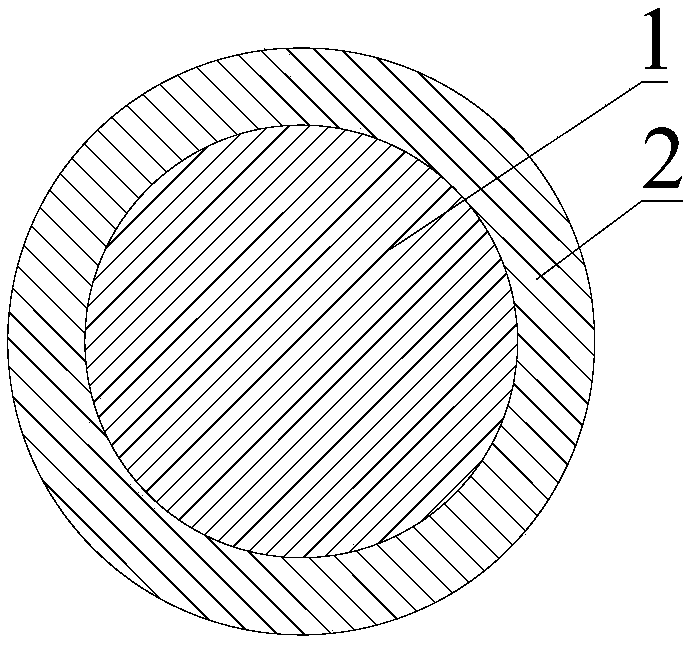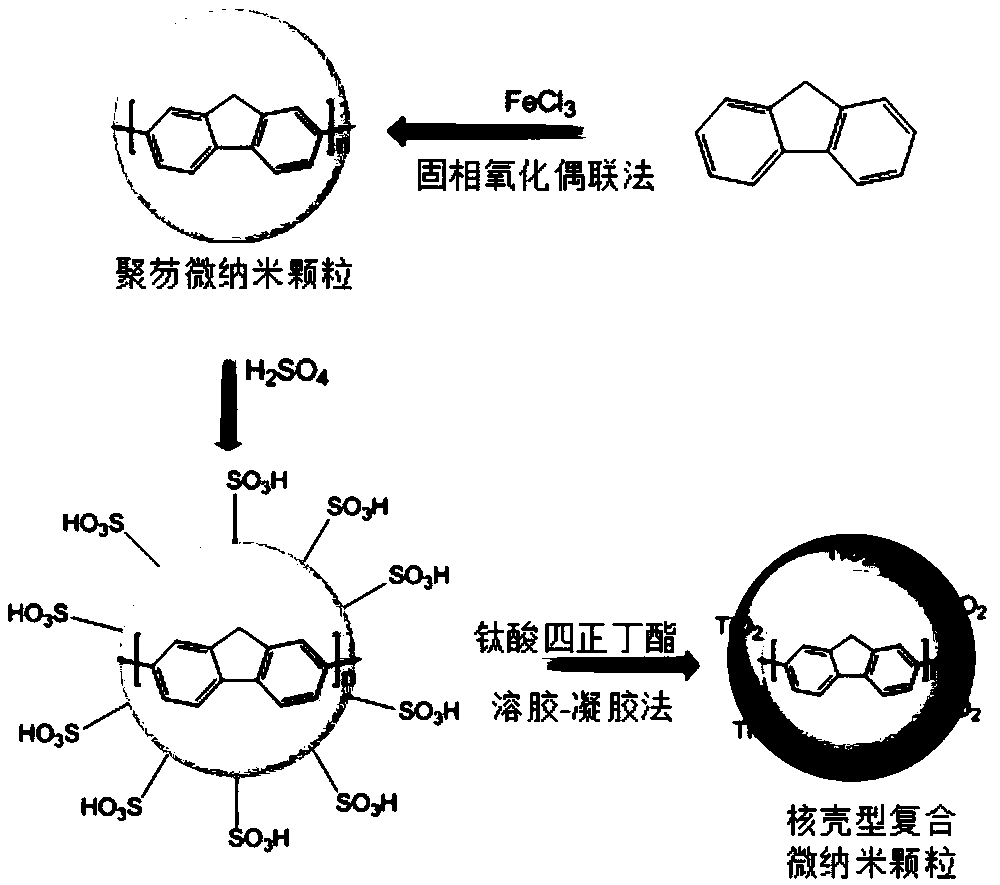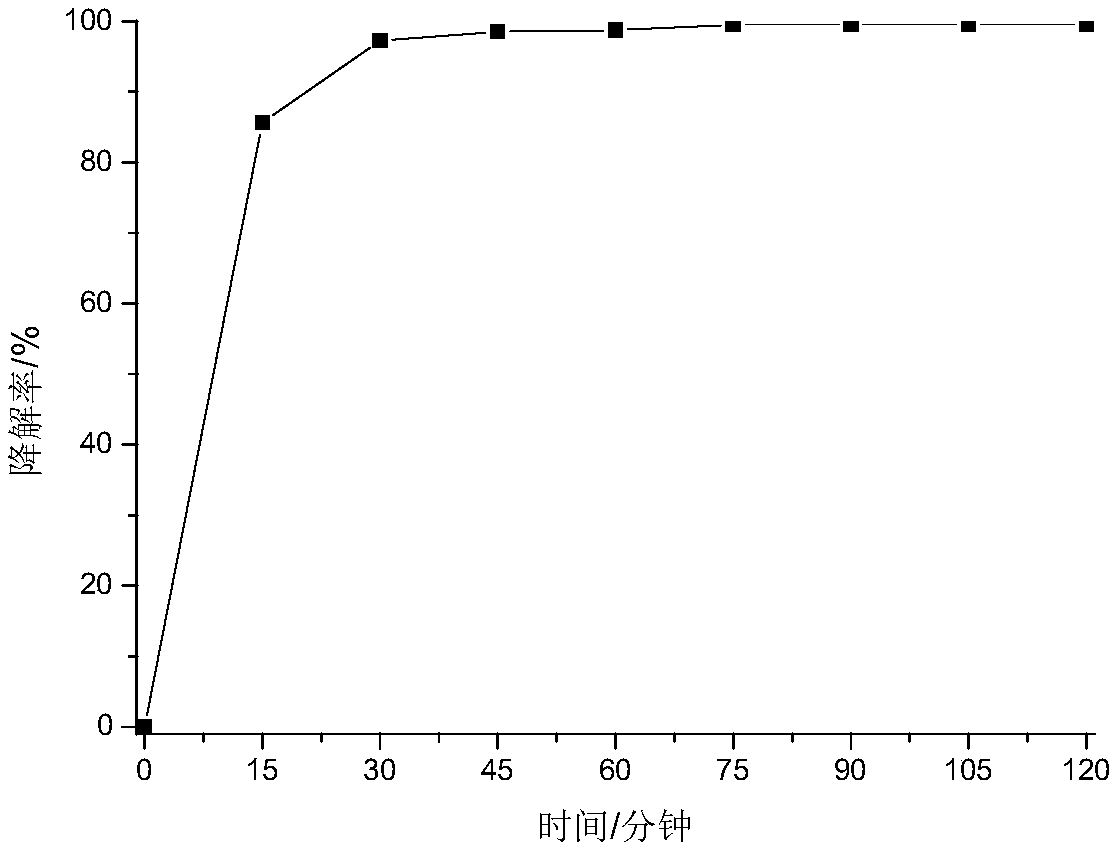Core-shell type composite micro-nanoparticles and preparation method thereof
A micro-nano particle, core-shell technology, used in chemical instruments and methods, special compound water treatment, organic compound/hydride/coordination complex catalysts, etc., can solve the problems of high temperature operation, harsh conditions, and complexity. Achieve the effects of mild reaction conditions, low cost and simple process
- Summary
- Abstract
- Description
- Claims
- Application Information
AI Technical Summary
Problems solved by technology
Method used
Image
Examples
Example Embodiment
[0022] A method for preparing core-shell composite micro-nano particles, using fluorene monomer as a raw material to prepare polyfluorene micro-nano particles by a solid-phase oxidative coupling method; sulfonating the polyfluorene micro-nano particles with concentrated sulfuric acid , To obtain sulfonated micro-nano particles; the sulfonated micro-nano particles and tetra-n-butyl titanate are sequentially adsorbed and hydrolyzed to obtain the core-shell composite micro-nano particles.
[0023] Reaction principle: Polyfluorene micro-nano particles can undergo sulfonation reaction in concentrated sulfuric acid, grafted with sulfonic acid groups, polyfluorene micro-nano particles with sulfonic acid groups can adsorb tetra-n-butyl titanate, tetra-n-titanate Butyl ester can be hydrolyzed to get TiO 2 , TiO 2 Coated on the surface of polyfluorene micro-nano particles to form core-shell micro-nano particles.
[0024] It can be seen from the above description that conjugated polymers are ...
Example Embodiment
[0039] Example one
[0040] Please refer to figure 1 , The first embodiment of the present invention is:
[0041] A core-shell type composite micro-nano particle, comprising a core layer 1 and a shell layer 2. The shell layer 2 is a titanium dioxide layer, the core layer 1 is a polyfluorene layer, and the core-shell type composite micro-nano particles The particle size is 5-10μm.
Example Embodiment
[0042] Example two
[0043] Please refer to figure 2 The second embodiment of the present invention is a method for preparing core-shell composite micro-nano particles, which includes the following steps:
[0044] Step 1: Put 0.83g (5mmol) of fluorene and 3.24g (20mmol) of anhydrous ferric chloride in a glass mortar, grind with a mallet for half an hour at room temperature, and then wash the mixture with 5% hydrochloric acid ethanol solution , Suction filtration and drying to obtain the crude product, and then extract with absolute ethanol to obtain polyfluorene micro-nano particles.
[0045] Step 2: Perform a sulfonation reaction between the polyfluorene micro-nano particles and concentrated sulfuric acid to obtain sulfonated micro-nano particles. Specifically: the polyfluorene micronanoparticles are first dispersed in absolute ethanol by ultrasonic dispersion, and then concentrated sulfuric acid is added to carry out the sulfonation reaction. The ultrasonic dispersion time is at ...
PUM
| Property | Measurement | Unit |
|---|---|---|
| Particle size | aaaaa | aaaaa |
Abstract
Description
Claims
Application Information
 Login to view more
Login to view more - R&D Engineer
- R&D Manager
- IP Professional
- Industry Leading Data Capabilities
- Powerful AI technology
- Patent DNA Extraction
Browse by: Latest US Patents, China's latest patents, Technical Efficacy Thesaurus, Application Domain, Technology Topic.
© 2024 PatSnap. All rights reserved.Legal|Privacy policy|Modern Slavery Act Transparency Statement|Sitemap



